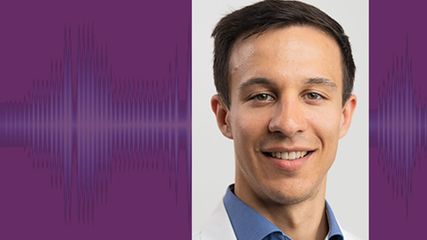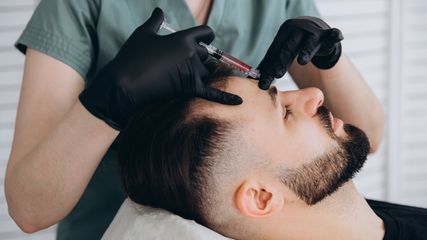
Störungen des Mikrobioms durch Einnahme von Antibiotika im ersten Lebensjahr
Die Publikationen selektierte:
PD Dr. sc. nat. Emmanuel Contassot
Projektleiter (Forschungsgruppe Navarini)
Abteilung Biomedizin
Universitätsspital Basel
E-Mail: emmanuel.contassot@unibas.ch
Des Weiteren beschäftigen wir uns mit dem Syk-Inhibitor Entospletinib, welcher die dermal-epidermale Trennung in einem vollständig humanen Ex-vivo-Modell des bullösen Pemphigoides aufhebt. Und es geht um die Wirkung von Staphylococcus aureus auf das Hautmikrobiom bezüglich Gewebereparatur nach Verletzungen.
Antibiotics taken within the first year of life are linked to infant gut microbiome disruption and elevated atopic dermatitis risk
Of all inflammatory skin diseases, atopic dermatitis (AD) is the most common in children. Indeed, AD diagnoses are increasing and often suggest broader dysregulation in immunological and skin barrier functions. Early-life AD is commonly followed by the development of additional allergic conditions, such as food allergies, asthma, and allergic rhinitis. AD incidence has been suggested to be linked to antibiotic exposure. A study, published in the Journal of Allergy and Clinical Immunology, shows in a prospective Canadian cohort of 3,455 childrena causal relationship between the use of antibiotics in the first 18 months of life and the onset of AD. The analysis of 1-year microbiomes of 1,179 children identified Bifidobacterium populations - essential to break down human milk oligosaccharides - as the most altered. In addition to the immediate consequences, this has also consequences for adults, since as the intestinal microbiota evolves, Bifidobacteria diminish and provide the substrates for cross-feeding acetate, which, along with propionate and butyrate, plays a crucial role in host physiology, notably in the maintenance of physical barriers, the function of intestinal epithelial cells and the activity of immune cells. This study therefore highlights the long-term deleterious consequences of exposure to systemic antibiotics in the first year of life and the need to rebalance the intestinal microbiome as early as possible.
Publication:
Hoskinson B et al.: Antibiotics taken within the first year of life are linked to infant gut microbiome disruption and elevated atopic dermatitis risk. J Allergy Clin Immunol 2024; 1: 131-42; https://doi.org/ 10.1016/j.jaci.2024.03.025
The Syk inhibitor entospletinib abolishes dermal-epidermal separation in a fully human ex vivo model of bullous pemphigoid
Bullous pemphigoid (BP) is a blistering disease caused by autoantibodies targeting hemidesmosomal proteins at the dermal-epidermal junction. Currently, there are no approved targeted therapies, and available treatments are primarily limited to general immunosuppression. Syk, a tyrosine kinase mainly expressed in hematopoietic cells, has emerged as a promising therapeutic target for immune-related disorders. In a study published in the Journal of Investigative Dermatology, Vikàr et al. assessed the efficacy of entospletinib, a well-tolerated oral Syk inhibitor, in preventing dermal-epidermal separation. Using an ex vivo human BP model, the authors demonstrated that entospletinib disrupts signal transduction triggered by IgG immune complexes and predominantly inhibits neutrophils. This led to a dose-dependent, significant reduction in dermal-epidermal separation without affecting the survival and migratory properties of granulocytes. These findings support Syk as a promising therapeutic target in BP.
Publication:
Vikàr S et al.: The Syk inhibitor entospletinib abolishes dermal-epidermal separation in a fully human ex vivo model of bullous pemphigoid. J Invest Dermatol 2024; 144(8): 1733-42; https://doi.org/10.1016/j.jid.2024.01.009
Selective depletion of staphylococcus aureus restores the skin microbiome and accelerates tissue repair after injury
The skin’s microbiota is complex and performs crucial functions. When it is out of balance, a phenomenon known as dysbiosis, the functions of the skin barrier can be altered to varying degrees. Staphylococcus aureus is one of the bacteria that can cause quite serious problems, particularly in the presence of wounds. The use of antibiotics can be ineffective, or even harmful, due to the existence of resistant strains and an action on the ‘beneficial’ microbiota. The use of new therapeutic agents such as bacteriophage-derived lytic enzymes, known as endolysins, is a promising alternative to traditional antibiotics. In porcine and human skin wound models, Wilkinson et al. demonstrate that the use of a chimeric endolysin XZ.700 leads to a drastic reduction in colonization by S. aureus while restoring the diversity of the microbiota. This results in an acceleration of the distribution. These observations are specific to S. aureus. In fact, while the products secreted by S. aureus delayed healing in the absence of treatment with XZ.700, the products secreted by other staphylococcal species could promote repair of the area treated with XZ.700. Thanks to its effectiveness and specificity, this approach is of obvious interest in the management of skin infections and wound repair.
Publication:
Wilkinson HN et al.: Selective depletion of staphylococcus aureus restores the skin microbiome and accelerates tissue repair after injury. J Invest Dermatol 2024; 144(8): 1865-76; https://doi.org/10.1016/j.jid.2024.01.018
Das könnte Sie auch interessieren:
HPV-assoziierte Hautveränderungen in Kombination mit HIV
Infektionen mit humanen Papillomaviren (HPV) zählen zu den häufigsten sexuell übertragbaren Infektionen. Man geht davon aus, dass weltweit 80–90% aller sexuell aktiven Erwachsenen im ...
Aktuelle Entwicklungen in der ästhetischen Medizin
Das Wachstum des ästhetischen Marktes beschränkt sich mittlerweile nicht mehr nur auf weibliche Patientinnen, männliche Patienten machen derzeit einen Anteil von etwa 8% aus, erklärte ...
Wundbehandlung jetzt und zukünftig – innovativ und vernetzt
Vom 5. bis 6. Dezember 2024 findet in der Meistersingerhalle in Nürnberg der 7. Nürnberger Wundkongress statt. Unter dem Motto „Wundbehandlung jetzt und zukünftig – innovativ und ...


